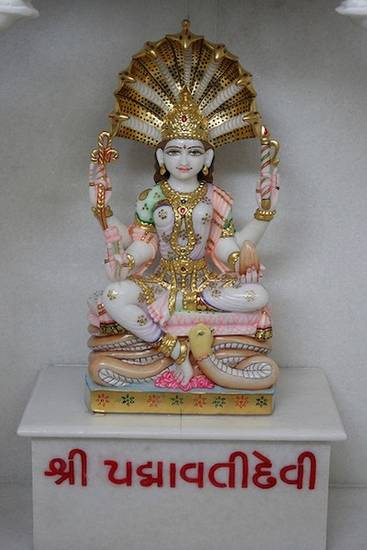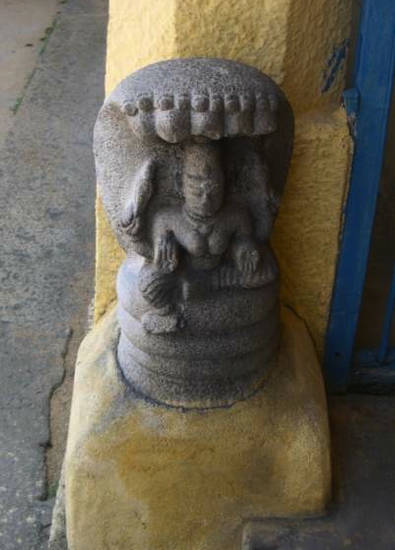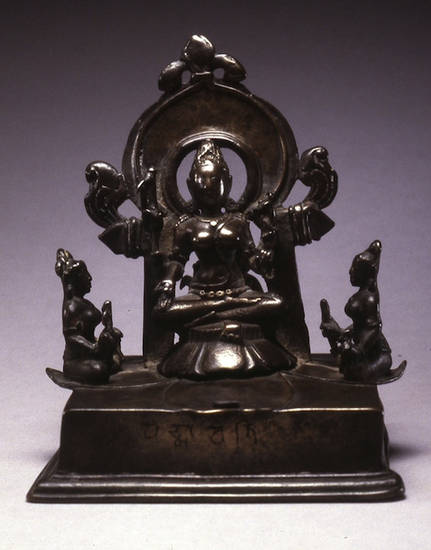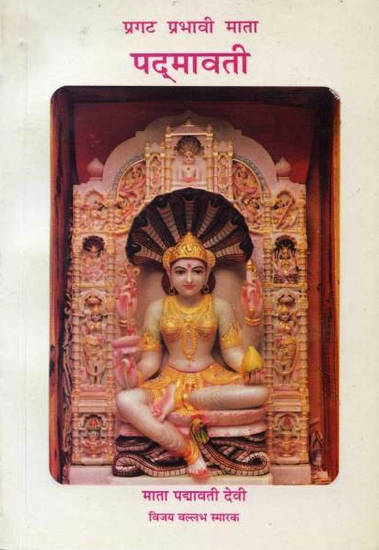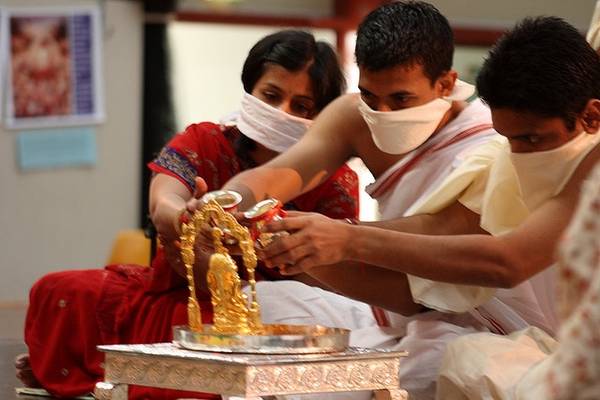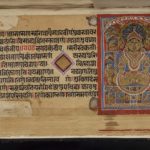Article: Padmāvatī
The yakṣī or female attendant deity of the 23rd Jina, Pārśvanātha or Lord Pārśva, is Padmāvatī. As a śāsana-devatā – ‘deity of the teaching’ – she is believed to help protect and spread the message of her Jina. Padmāvatī is one of the most important Jain goddesses among both Digambaras and Śvetāmbaras and is worshipped all over India. She is the focus of individual worship partly because of her associations with wealth.
As a goddess, Padmāvatī is a soul subject to the cycle of birth and can intervene in human affairs, unlike Jinas, who are liberated, perfect souls, completely detached from everyday human experience. Lay Jains worship gods partly to request help with worldly matters, ranging from issues of health and fertility, and passing examinations to business success. By the tenth century several of the śāsana-devatās had developed into independent gods at the centre of their own cults. This may be because of their connections with the major Jinas, links with a prominent pilgrimage centre or various stories of their powers.
Padmāvatī is assigned different attributes and divine vehicles by the two main sects of Jainism. However, among both she is frequently linked to the snake, the emblem of her Jina, Pārśva. Padmāvatī is particularly significant among Jains in Karnataka, especially the Digambara centres of Hombuja or Humcha and Shravana Belgola.
Roles
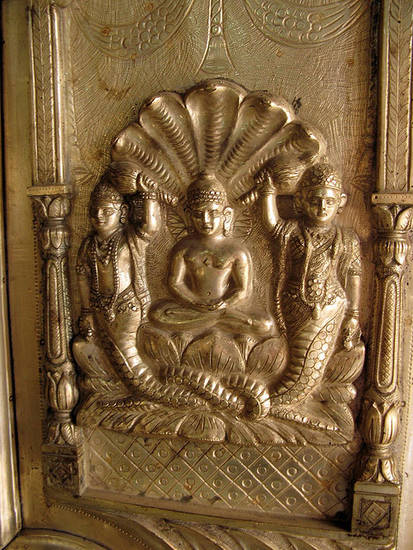
Pārśva attended by yakṣa and yakṣī
Image by Cactusbones – Sue Ann Harkey © CC Attribution-NonCommercial-ShareAlike 2.0
Padmāvatī is the yakṣī of the Jina Pārśvanātha or Lord Pārśva. She is linked to wealth and snakes, and can cure snakebites, which happen quite frequently in India. Although Padmāvatī’s origins are unclear, she was probably originally a local clan deity.
Padmāvatī’s male counterpart, the yakṣa, is known as Dharaṇendra to Śvetāmbaras and Pārśva or Mātanga to Digambaras. With a snake as his emblem, the 23rd Jina is closely associated with snakes and is usually depicted with a hood of snake-heads. The snakes refer to Pārśva’s relationship with his yakṣa, whom Śvetāmbara Jains believe is the reincarnation of the snake Dharaṇendra. Before he became a monk, Prince Pārśva saved the snake from death and, later, Dharaṇendra sheltered the meditating ascetic from torrential rainfall. However, whereas the yakṣa’s association with the Jina is well rooted in tradition, this is not the case with Padmāvatī.
Instead, Padmāvatī’s identity as Pārśva’s yakṣī is the result of various interactions and influences. It is believed that her connection with the 23rd Jina is rather late, as it is not seen in art before the tenth century. She may have replaced the earlier snake-goddess Vairoṭyā, who is the 13th of the 16 vidyā-devīs. But this is unclear.
Padmāvatī has connections with snakes, being credited with the ability to cure snakebites, which may be one of the reasons she became associated with Pārśva. She is also a goddess of wealth, which is another connection with this Jina.
She is likely to have been originally a clan deity – kula-devī – who was integrated into the Jain system of values. Inscriptions from Karnatak show that members of local ruling families in the medieval period often stated that they were devotees of Padmāvatī (Cort 1987: 243).
Appearance
Both yakṣas and yakṣīs are considered part of the entourage of the Jina image, technically known as parikara. Like all of the attendant deities, Padmāvatī has certain features that help to identify her and indicate her powers. These are described in, for example, texts on the iconography of the Jina, which outline the appearance of the Jina’s attendants.
Being presented as a deity implies that Padmāvatī has special characteristics linked to the depiction of gods in art. This means she:
- may have more than two arms or hands
- has a vehicle – vāhana
- demonstrates attributes by holding various objects
- may exhibit hand-gestures that symbolise a concept or attitude – mudrās.
However, it is quite common to see goddesses such as Padmāvatī, who have also developed into independent deities, as large images with a miniature Jina depicted above their heads.
Padmāvatī’s divine vehicle varies according to the two main Jain sects. The Śvetāmbaras consider her vehicle to be either the snake or cockerel and depict her with four hands, holding a lotus, noose, fruit and goad. Here is how the 12th-century author Hemacandra describes her:
The goddess Padmāvatī, with a kurkuṭa-serpent for a vehicle, gold colored, carrying a lotus and a noose in her right hands, a fruit and a goad in her left hands, became the second messenger-deity of Lord Pārśva.
Triṣaṣṭiśalākāpuruṣacarita IX.3. 363–365
Johnson’s translation, volume 5, page 403
Digambara images show various attributes depending on the number of hands. For instance, a four-armed Padmāvatī from Deogarh in Uttar Pradesh makes the gesture of giving a boon – varada-mudrā – and holds a noose, lotus and shield (Tiwari and Sinha 2011/112). Additional attributes would be a lotus, jug, goad, manuscript, staff, fruit, bow and so on. There is no full standardisation in this matter.
An image of Padmāvatī is a common sight in niches located in the entrance hall of a large number of temples. She is often seen clothed in colourful silks, mainly red or golden. Silk is a precious, costly material and red silk, often with golden threads, is traditional bridal attire at Indian weddings. These garments underline her connection with wealth.
Stories
There are numerous instances in stories where Padmāvatī provides help or rescue for people in need. In these tales she aids ordinary people as well as religious or political leaders, especially among Digambaras.
Dated 1129 CE, the Shravana Belgola inscription number 77 reports that Padmāvatī helped the Jain teacher Pātrakesari defeat his opponents (Cort 1987: 245).
In a collection of stories from the 13th century it is narrated how a king wants to protect his city from the approaching Muslim army. He asks the help of a Digambara monk who he knew had obtained a boon from Padmāvatī. Instructed by the monk, the king worships the goddess during the night:
The Digambara that very night began a sacrifice before Padmāvatī in the presence of the king. Then Padmāvatī, brought there by his perfect power of attracting spirits, appeared within the garland of flame in the sacrificial pit, and said that she had forbidden the approach of the [Muslims].
Merutunga, Prabandha-cintāmaṇi
Tawney 1982 reprint, page 185
The outcome in this tale is unsuccessful because the deity the monk worshipped was not actually Padmāvatī but a foreign deity in disguise.
Another story tells how Padmāvatī played a major role in the foundation of the Śāntara dynasty of Karnatak (Cort 1987: 245). First she assists the founder of the dynasty, Jinadatta, to triumph over his threatening father. The goddess helps Jinadatta escape his father and then, when he is pursued, she creates the illusion that he leads a greater army than that of his father. Jinadatta’s father and his army turn back and Jinadatta flees the kingdom. Next Padmāvatī ‘told the penniless Jinadatta to touch an iron bar to the vulva of her image, whereupon the bar turned into the gold he needed to found a city’. But later on she disappears in anger because she finds out that Jinadatta has given her a fake pearl. Of the two pearls Jinadatta discovers, he offers the goddess the fake and presents the real one to his wife.
These two stories demonstrate how unpredictable the goddess can be. Such accounts emphasise the nature of deities as beings caught in the world of rebirths and prone to passions – kaṣāyas – or desires. As Zydenbos remarks (1994: 143), with Padmāvatī ‘there is always a mystery that is never completely solved and gives a twist to the course of the story’.
In other circumstances, Padmāvatī is said to have appeared to the 12th-century Digambara monk Śrīdhara. She approved his proposal of establishing an image of a Jina, despite the opposition of his disciple (Guérinot 1926: 54–55). This story occurs in the context of the birth of the Śvetāmbara monastic lineage known as the Pūrṇimā-gaccha.
Temples
Although Padmāvatī is popular throughout India, her worship is especially strong in southern India. There are scores of temples dedicated to her in southern India, particularly in Karnatak. Indeed, Padmāvatī is so popular in Karnatak that she is associated with other Jinas as well as Pārśvanātha or Lord Pārśva.
Among Digambaras, Padmāvatī is associated in particular with Hombuja or Humcha in the Shimoga district of Karnatak and with Shravana Belgola in Karnatak. The growth of these centres of pilgrimage is entwined with Padmāvatī’s rise as an individual figure of worship.
Hombuja
Padmāvatī’s link with Hombuja – also known as Humcha – dates back to an old legend told in the Padmāvatī-māhātmya by Padmanābha, in Kannara (Zydenbos 1994: 138). It might have been composed in the 17th century in this form but may well be older than that.
About 1300 years ago King Jinadatta reaches Humcha after fleeing from north India. As his guru has advised, the king carries a statue of Padmāvatī to protect him. The goddess herself appears to him at Hombuja and says that she will not travel any further. Jinadatta becomes king of the local tribal people, clears the forest and builds his new capital city. Padmāvatī becomes the presiding deity of the place and the city grows wealthy and powerful, as any bar of iron she touches turns to gold (for example, see Zydenbos 1994: 138; Titze 1998: 39–41; Cort 2010: 347). When Jinadatta offers to build her a temple, she agrees only after he promises to build a temple for the Jina whom she attends, namely Pārśva. Thus she demonstrates her respect for the Jina (Zydenbos 1994: 142).
Hombuja became a major pilgrimage place, especially for Digambara Jains. It houses a temple to Pārśva and one to Padmāvatī as well as temples dedicated to other Jinas. Bhaṭṭāraka Devendrakirtiji managed the site until his death in 2010. In November 2011 a new young bhaṭṭāraka, Dharmakirti, took charge.
Shravana Belgola
Padmāvatī is also a focus of devotion in Shravana Belgola (Cort 2010: 349), along with the goddess Ambikā or Kūṣmāṇḍinī, who is also a yakṣī.
Particularly noticeable is the image of Padmāvatī in the Kattale Basadi on Candra-giri, the small hill. This temple has come to be known as ‘Padmāvatī Basadi‘ on account of her importance.
Other places
This south Indian emphasis does not mean that shrines or temples to Padmāvatī are not found anywhere else. They are increasingly built everywhere in India and beyond.
One contemporary example is the Padmāvatī shrine in the larger Śvetāmbara complex of the Vijayavallabha Smārak temple in Karnal, about 20 kilometres from Delhi. Sādhvī Mr̥gāvatījī had the idea for the building project, which gained the blessing of the Tapā-gaccha leader Vijayendradinna-sūri. The temple housing the cult image was inaugurated in May 1984.
The motivation behind the temple’s construction is to discourage lay Jains from going to fakirs and non-Jain gods and goddesses in the hope of fulfilling their wishes. Instead, it is said that Padmāvatī can guarantee all types of success and remove all kinds of obstacles for devotees following the right path. This is because she has marvellous powers and is the attendant of Pārśvanātha or Lord Pārśva (Jain 1984: 5).
Worship
Paying due homage to Padmāvatī is usually performed using the standard rituals of Jain worship. However, the story of the Digambara monk who worshipped Padmāvatī with the aim of preventing Muslims entering the king’s capital shows how ordinary Jain worship may be supplemented or replaced by other practices. These may be quite standard Jain practices, such as meditation, or less orthodox rites, such as making sacrifices to fire.
Even so it is important to emphasise that physical and moral purity are crucial to guarantee the success of the rituals. Moral purity implies following proper Jain conduct.
Tantric rituals
Padmāvatī is often worshipped the Tantric way. Jain Tantric worship aims to control other people or counter evil influences and involves performing rituals to placate the aggressive side of the deity’s nature, encouraging the divinity to behave benevolently. If not worshipped correctly, the vengeful deity may cause harm.
The main source to this effect is a kalpa text, which sets out rituals and yantras for efficient, successful worship. The Digambara monk Malliṣeṇa wrote the Bhairava-Padmāvatī-kalpa – Manual of Rituals to the Fierce Padmāvatī – in 1057 CE in Karnatak. This work in Sanskrit verse has a commentary by a writer called Bandhuṣeṇa, about whom hardly anything is known (Jhavery 1944; Nawab 1937/1996).
This kalpa is divided into ten chapters (see Jhavery 1944: 295–299 for a summary).
|
Chapter number |
Number of verses |
Contents |
|---|---|---|
|
1 |
11 |
Moral qualities required from the practitioner, who is called:
|
|
2 |
21 |
Rites for the protection of the practitioner and:
|
|
3 |
40 |
Method for achieving the ‘six acts’, here listed as:
The mode of worship of the deity with the relevant yantra is described. |
|
4 |
21 |
Description of 12 yantras used to meet various aims |
|
5 |
22 |
Yantras for achieving immobilisation – stambhana – which results in ‘paralysing persons and their activities and passing successfully through various ordeals’ (Jhavery 1944: 297) |
|
6 |
19 |
Yantras and mantras for fascinating women |
|
7 |
41 |
Yantras and mantras used to control others and make them do as the practitioner wishes |
|
8 |
33 |
Mantras for divination using various objects, such as gazing into a mirror, lamp-flame, sword, water or a thumb to which soot and oil are applied |
|
9 |
42 |
Medicinal herbs and powders to control women or other people and make them do what the practitioner wishes |
|
19 |
57 |
Science for controlling and catching snakes or treating people who have been bitten – garuḍa-vidyā or garuḍa-tantra |
The number of hymns or kalpas dedicated to this goddess is almost infinite. A good collection of Sanskrit texts is found in the appendices to Nawab 1937/1996. Analysis on pages 307 to 316 in Jhavery 1944 gives insight into the different modes of Padmāvatī’s worship.
There are many more such texts in Hindi, Gujarati, Tamil and Kannara. They are available in all forms, for example in low-cost booklets found in local shops and temples (see Jain 1984 for instance) in India.
Reading
- The Jaina Iconography
B. C. Bhattacharya - Motilal Banarsidass; Delhi, Varanasi, Uttar Pradesh and Patna, Bihar in India; 1974
- ‘The Goddesses of Sravana Belgola’
John E. Cort - Svasti – essays in honour of Prof. Hampa Nagarajaiah for his 75th Birthday
edited by Nalini Balbir
Muddushree Granthamala series; volume 75
K. S. Muddappa Smaraka Trust; Bangalore, Karnataka, India; 2010
- The Jains
Paul Dundas - Library of Religious Beliefs and Practices series; series editor John Hinnels and Ninian Smart; volume 14
Routledge Curzon Press; London, UK; 2002
- ‘Some Thoughts on the Identification of Jaina Images in Tamilnadu’
A. Ekambaranathan - Svasti – essays in honour of Prof. Hampa Nagarajaiah for his 75th Birthday
edited by Nalini Balbir
Muddushree Granthamala series; volume 75
K. S. Muddappa Smaraka Trust; Bangalore, Karnatak, India; 2010
- Comparative and Critical Study of Mantrashastra (With Special Treatment of Jain Mantravada): Being The Introduction to Sri Bhairava Padmavati Kalpa
Mohanlal Bhagwandas Jhavery - Sri jain kala sahitya samsodhak (Jain Art Publication) series; volume 1
Sarabhai Manilal Nawab; Ahmedabad, Gujarat, India; 1944
- Opulent Candragiri
Hampa Nagarajaiah - S.D.J.M.I. Managing Committee; Shravanabelgola, Karnataka, India; 2001
- Vividha Kalpa Saṃgraha: Mul, gujarātī bhāṣāntara, mantra-yantra-tantra no saṃgraha pariśiṣṭo sāthe
Nawab Sarabhai Manilal and Nawab Rajendra Sarabhai - Śrī Jaina kalā sāhitya saṃśodhana granthamālā series; volume 22
Amadāvāda; Ahmedabad, Gujarat, India; 1998
- Śrī Bhairavapadmāvatīkalpa: śrīBandhuṣeṇa nī vistṛta ṭīkā tathā śuddha mantragarbhita 31 pariśiṣṭo sahita [aneka yantrakṛtio sāthe] dvitīya saṃvṛddhita āvṛtti [ādya sampādaka Sva. Prof. K.V. Abhyankar]
Malliṣeṇasūriviracita - Nawab Sarabhai Manilal; Ahmedabad, Gujarat, India; 1996
- Padmāvatī ādi śāsana devoṃ kā astitva hī nahīṃ
Viradhīlāl Seṭhī - Jain Saṃskr̥ti Saṃrakṣaṇ Samiti
- The Jain Saga: 63 Illustrious Persons of the Jain World, Brief History of Jainism
Hemacandra - translated by Helen M. Johnson
edited by Muni Samvegayashvijayji Maharaj
Acharya Shrimad Vijay Ramchandra Suriswarji Jain Pathshala; Ahmedabad, Gujarat and Mumbai, Maharashtra, India; 2009
- The Prabandhacintāmaṇi or Wishing-stone of Narratives
Merutunga Ācārya - translated by C. H. Tawney
Indian Book Gallery; Delhi, India; 1982
- The Concept of Divinity in Jainism
Robert J. Zydenbos - Centre for South Asian Studies of the University of Toronto; Toronto, Canada; 1993
- ‘Göttinverehrung im Jainismus’
Robert J. Zydenbos - Aspekte der Weiblichen in der indischen Kultur
edited by Ulrike Roesler
Indica et Tibetica series; volume 39
Indica et Tibetica; Swisttal-Odendorf, North-Rhine-Westphalia, Germany; 2000
Links
- Brass figure of Padmāvatī
-
Metal image of Padmāvatī, the popular Jain goddess. Frequently depicted under a canopy of snakehoods, she is associated with wealth and success and is worshipped by both main Jain sects. She is also the attendant goddess – yakṣī – of the 23rd Jina Pārśvanātha or Lord Pārśva. Atop her seven-headed snake canopy sits a small figure of Pārśva, who also has his characteristic snakehood canopy. The University of Michigan Museum of Modern Art in the USA provides a zoomable photograph of the statue and metadata.
http://quod.lib.umich.edu/m/musart/x-1977-sl-2.47/1977_2.47.jpg
- Padmāvatī and snakehoods
-
Flickr provides a 2011 photograph of a damaged statue of the goddess Padmāvatī. The snakehoods above the figure's head and her ornate jewellery help identify her. Padmāvatī is the female attendant deity – yakṣī – of the 23rd Jina Pārśva and is popular throughout India as an independent goddess.
- Gilt Padmāvatī
-
Gilt-covered image of the goddess Padmāvatī. A powerful and popular deity, who is particularly worshipped in south India, she is associated with wealth and success. She is also the yakṣī – attendant goddess – of the 23rd Jina Pārśvanātha or Lord Pārśva. The Ethnoarte website provides several photographs of this 18th-century image from Maharashtra.
- Painting of Padmāvatī
-
The Victoria and Albert Museum in London provides a video of a British Jain, Dinesh Shah, explaining the significance of the goddess Padmāvatī. He describes the history and appearance of a family painting of the deity. Padmāvatī is the yakṣī – female attendant deity – of the 23rd Jina, Pārśva, and is also a popular goddess in her own right.
http://www.vam.ac.uk/content/articles/v/videos-stories-about-jain-objects/
- Padmāvatī and attendants
-
Śvetāmbara image of the goddess Padmāvatī and attendants. Popular all over India, but especially in the south, Padmāvatī is a powerful deity associated with wealth and the ability to cure snakebite. She is also the yakṣī or female attendant deity of the 23rd Jina, Pārśvanātha or Lord Pārśva, who is the small figure above her head, sheltering under a canopy of snakehoods. The Metropolitan Museum of Art in New York, USA, provides views of both sides of the artefact.
http://www.metmuseum.org/Collections/search-the-collections/60051141
- Decorated figure of Padmāvatī
-
Richly decorated statue of the goddess Padmāvatī in Leicester, England on the Flickr website. A contemporary Śvetāmbara image, the figure has flower offerings at her feet. This goddess is the female attendant deity – yakṣī – of Pārśva, the 23rd Jina. She is also a very popular individual deity, worshipped across India and among the Jain diaspora.
- Pārśva and retinue
-
An 11th-century image of the 23rd Jina Pārśvanātha or Lord Pārśva and two unidentified Jinas. At the bottom sit his male attendant deity – yakṣa – Dharaṇendra and his female attendant deity – yakṣī – Padmāvatī. Dharaṇendra is the reincarnation of a snake Pārśva saved from death while Padmāvatī is a popular goddess in her own right, also closely associated with snakes. This photograph of the bronze image is on the website of the Norton Simon Museum in Pasadena, California, USA.
http://www.nortonsimon.org/collections/browse_title.php?id=F.1975.06.S
- Pārśva and attendants
-
A painting of the 23rd Jina Pārśvanātha or Lord Pārśva in the lotus pose of meditation, held aloft by a four-armed goddess. Either side of him with hands clasped in prayer are his attendant deities, represented as half-snake, half-human figures. His yakṣa Dharaṇendra is on the left and his yakṣī Padmāvatī on the right. This 19th-century image is available via Calisphere, a service of the UC Libraries, powered by the California Digital Library.
http://content.cdlib.org/ark:/13030/kt3w100366/?layout=metadata&brand=calisphere
- +
- aAbhavya
- aAbhinandana
- aAbhiṣeka
- aĀcāra
- aĀcārāṅga-sūtra
- aĀcārya
- aAchalbhrata
- aAḍhāī-dvīpa
- aAdharma
- aAdho-loka
- aAdhyayana
- aAdvaita Vedānta
- aĀgama
- aAghātīya
- aAghātīya-karman
- aAgnibhuti
- aAgra
- aĀhāra
- aAhiṃsā
- aAhimsa Day
- aAjita
- aAjīva
- aAkampit
- aĀkāśa
- aAkbar the Great
- aAkṣaya-tṛtīyā
- aAlauddin Khalji
- aAlbert Einstein
- aAllah
- aAlms
- aĀlocanā
- aAloka-ākāśa
- aAmāri
- aAmbikā or Kūṣmāṇḍinī
- aAnagāra
- aAnanta
- aAnarthadaṇḍa
- aAnaśana
- aAnekānta-vāda
- aAṅga
- aAniconism
- aAnojjā
- aAntarāla
- aAntarāya-karma
- aAṇu
- aAṇu-vrata
- aAnukampā
- aAnuprekṣā
- aAnusvāra
- aApabhraṃśa
- aAparigraha
- aAra
- aĀrambha
- aĀrambhaja
- aĀratī
- aArdhamāgadhī Prākrit
- aArhaṃ
- aArhat
- aArśana-āvaraṇīya-karma
- aĀrta-dhyāna
- aĀryikā
- aĀryikā Jñānamati
- aĀśātanā
- aĀścarya
- aAscetic
- aAsceticism
- aAshram
- aAspiration
- aĀsrava
- aAṣṭa-maṅgala
- aAṣṭāpada
- aAstikāya
- aAstrolabe
- aAsura
- aAtheism
- aAticāra
- aAtiśayakṣetra
- aAtithisaṃvibhāgavrata
- aĀtma-vāda
- aĀtman
- aAuṃ
- aAurangzeb
- aAuspicious
- aAusterity
- aAvadhāna
- aAvadhi-jñāna
- aĀvaraṇī-yakarman
- aAvasarpiṇī
- aAvatāra
- aAvidyā
- aAxiom
- aĀyāga-paṭa
- aĀyambil
- aĀyu-karma
- aĀyurveda
- bBabur
- bBāhubali
- bBaladeva
- bBālāvabodha
- bBandha
- bBasadi
- bBazaar
- bBhadrankarvijay
- bBhagavant
- bBhaktāmara-stotra
- bBhakti
- bBhale
- bBharata
- bBhāṣā
- bBhāṣya
- bBhaṭṭāraka
- bBhāva
- bBhāva-pūjā
- bBhāvanā
- bBhavana-vāsin
- bBhavya
- bBhavyatva
- bBhaya
- bBhoga-bhūmi
- bBhogopabhoga
- bBodhi
- bBollywood
- bBrahmā
- bBrahma-deva
- bBrahmacārī
- bBrāhmaṇa
- bBraj Bhāṣā
- bBright fortnight
- bBritish Raj
- bBuddha
- bBuddhi-sagar
- bBuddhism
- bBuddhist
- cCaitya
- cCaityavāsin
- cCakravartin
- cCakreśvarī
- cCāmara
- cCandanā
- cCandragupta
- cCandraprabha
- cCanon
- cCāritra
- cCāritramohanīya-karman
- cCarũrī
- cCaste
- cCaturvidha-saṅgha
- cCaturviṃśati-stava
- cCāturyāma
- cCE
- cCelibacy
- cCha
- cChadmastha
- cChastity
- cCheda-sūtra
- cChristian
- cChristianity
- cClergy
- cCloning
- cColophon
- cCommentary
- cConch
- cConfession
- cCongregation
- cConsecration
- cCosmology
- cCremation
- cCrore
- cCult
- cCūrṇi
- dDādā-guru
- dDalit
- dDāna
- dDaṇḍa
- dDark fortnight
- dDarśana
- dDarśanamohanī-yakarman
- dDaśa-lakṣaṇa-parvan
- dDeity
- dDelhi Sultanate
- dDerāsar
- dDeśāvakāśika-vrata
- dDetachment
- dDevanāgarī
- dDevānandā
- dDevarddhi-gani
- dDevotee
- dDhamal
- dDhanuṣ
- dDhāra
- dDharma
- dDharma-dhyāna
- dDharma-sāgara
- dDharmastikaya
- dDhātakīkhaṇḍa
- dDholak
- dDhyāna
- dDiaspora
- dDig-vrata
- dDigambara
- dDīkṣā
- dDisciple
- dDīvālī
- dDivya-dhvani
- dDNA
- dDoctrine
- dDogma
- dDonor
- dDoṣa
- dDravya
- dDravya-pūjā
- dDrone
- dDuṣamā
- dDuṣamā-duṣamā
- dDuṣamā-suṣamā
- dDveṣa
- dDvīpa
- eEast India Company
- eEightfold Path
- eEkānta-vāda
- eEkendriya
- eElder
- eElders
- eEschatology
- eEtc up to
- fFarmān
- fFast
- fFatehpur Sikri
- fFestival
- fFestschrift
- fFiruz Shah
- fFly-Whisks
- fFolio
- fFour Noble Truths
- gGaccha
- gGaṇa
- gGaṇadhara
- gGanadharavada
- gGaṇeśa
- gGaṇin
- gGarba
- gGarbha
- gGarbha-gṛha
- gGaruḍa
- gGati
- gGene
- gGenomics
- gGhātī-yakarman
- gGhātīya
- gGhaznavid
- gGhiyasuddin Tughlaq
- gGhurid
- gGloss
- gGotra-karma
- gGujarāt
- gGujarati
- gGuṇa
- gGuṇa-sthāna
- gGuṇa-vrata
- gGupti
- gGuru
- gGuruṇī
- hHagiography
- hHajj
- hHaṃsa
- hHaribhadra
- hHariṇaigameṣin
- hHasta
- hHeresy
- hHiṃsā
- hHindi
- hHindu
- hHinduism
- hHīravijaya
- hHoroscope
- hHrīṃ
- hHumayun
- hHymn
- iIconoclasm
- iIconography
- iIdol
- iIndian Independence
- iIndology
- iIndra
- iIndrabhūti Gautama
- iIndriya
- iInitiation
- iIntercession
- iInvocation
- iIQ
- iIslam
- iIslamicate
- iIṣṭadevatā
- iĪśvara
- jJagat
- jJahangir
- jJain
- jJaina Devanāgarī
- jJaina Śaurasenī
- jJaina-dharma
- jJainaśāsana
- jJainness
- jJaisalmer
- jJamāli
- jJambū-dvīpa
- jJames Burgess
- jJanma
- jJanma-kalyāṇa
- jJarā
- jJāti
- jJina
- jJina-āgama
- jJina-bhavana
- jJina-bimba
- jJina-mātā
- jJinacandra-sūri
- jJinadatta
- jJinaprabha
- jJīva
- jJñāna
- jJñāna-āvaraṇīya-karma
- jJñāna-āvarṇiya
- jJñānsundar
- jJyotiṣka
- kKāla
- kKālakācārya-kathā
- kKālidāsa
- kKalpa-sūtra
- kKalpa-vṛkṣa
- kKalyāṇaka
- kKalyanvijay
- kKamaṇḍalu
- kKamaṭha
- kKarma
- kKarma-bhūmi
- kKarma-grantha
- kKarma-prakṛti
- kKarma-vāda
- kKarmon
- kKarnataka
- kKaṣāya
- kKathā
- kKāvya
- kKāya
- kKāyotsarga
- kKeśa-loca
- kKetu
- kKevala-jñāna
- kKevalin
- kKhalji
- kKharatara-gaccha
- kKnowledge
- kKriyā
- kKriyā-vāda
- kKṛṣṇa
- kKṣamā-śramaṇa
- kKṣapakaśreṇi
- kKṣatriya
- kKṣullaka
- kKulakara
- kKundakunda
- kKunthu
- lLabdhi
- lLaity
- lLakh
- lLāñchana
- lLands of Action
- lLaukāntika
- lLavaṇa-samudra
- lLeśyā
- lLiṅga
- lLinguistics
- lLoka
- lLoka-ākāśa
- lLoka-puruṣa
- lLoka-vāda
- lLotus
- lLotus lake
- mMadhya-loka
- mMahā-videha
- mMahā-vrata
- mMahābhārata
- mMahāmastakābhiṣeka
- mMāhārāṣṭra
- mMāhārāṣṭrī Prākrit
- mMahattarā Yākinī
- mMahāvīr Jayantī
- mMahāvīra
- mMakāra
- mMakkhali Gośāla
- mMalli
- mMāna-stambha
- mManaḥ-paryāya-jñāna
- mMaṇḍala
- mMaṇḍapa
- mMandit
- mMaṅgala
- mMantra
- mMantras
- mManuṣya-loka
- mMarāṭhī
- mMārgaṇā
- mMartyr
- mMarudevī
- mMaṭha
- mMati-jñāna
- mMauryaputra
- mMecca
- mMendicant lineage
- mMetarya
- mMiracle
- mMithyādṛṣṭi
- mMohandas Gandhi
- mMohanīya-karma
- mMokṣa
- mMonastic order
- mMonasticism
- mMonk
- mMonotheism
- mMosque
- mMount Meru
- mMount Sammeta
- mMṛgāvatī
- mMughal
- mMuhammad
- mMuhammad bin Tughlaq
- mMuhpattī
- mMūla-sūtra
- mMūlaguṇa
- mMumbaī
- mMuni
- mMunisuvrata
- mMurad Bakhsh
- mMūrti-pūjaka
- mMuslim
- mMysticism
- nNābhi
- nNāga-kal
- nNāgapurīya Tapā-gaccha
- nNāgarī
- nNāma-karma
- nNamaskāra-mantra
- nNami
- nNandīśvara-dvīpa
- nNandivardhana
- nNandyāvarta
- nNāraka
- nNāraki
- nNasalisation
- nNātha
- nNavrātrī
- nNaya-vāda
- nNemi
- nNidāna
- nniggaṃthāṇa vā 2
- nniggaṃtho vā 2
- nNigoda
- nNihnava
- nNikṣepa
- nNirgrantha
- nNirjarā
- nNirvāṇa
- nNiryukti
- nNiṣidhi
- nNitya
- nNiyati
- nNo-kaṣāya
- nNudity
- nNun
- oOcean of milk
- oOmniscience
- oOrdination
- ppa°
- pPadmaprabha
- pPadmāsana
- pPadmāvatī
- pPādukā
- pPalanquin
- pPalette
- pPañca-muṣṭi
- pPāṇḍava
- pPaṇḍit
- pPandit Dalsukh D. Malvania
- pPandit Sukhlalji
- pPāṇipātra
- pPāpa
- pParamātman
- pParameṣṭhin
- pPāraṇā
- pParigraha
- pPariṇāma
- pParīṣaha
- pParokṣa
- pPārśva
- pPārśvanātha
- pParyāya
- pParyuṣaṇ
- pPaṭa
- pPatan
- pPātra
- pPenance
- pPersian
- pPhala
- pPhilology
- pPicchikā
- pPilgrimage
- pPīr
- pPolymath
- pPoṣadha
- pPossession
- pPothī
- pPrabhas
- pPradakṣiṇā
- pPradeśa
- pPrākāra
- pPrakīrṇaka-sūtra
- pPrākrit
- pPramāda
- pPramukhā
- pPrati-vāsudeva
- pPratikramaṇa
- pPratimā
- pPratiṣṭhā
- pPratyākhyāna
- pPratyakṣa
- pPravacana
- pPrāyaścitta
- pPrayer
- pPre-modern
- pPreach
- pPredestination
- pProtestant
- pProvenance
- pPudgala
- pPūjā
- pPujārī
- pPukharavara-dvīpa
- pPuṇya
- pPūrva
- pPuṣkara-dvīpa
- pPuṣpadanta
- pPyre
- qQur’an
- rRāga
- rRāhu
- rRainy season
- rRajasthan
- rRajasthani
- rRājimatī
- rRajoharaṇa
- rRajput
- rRāma
- rRāmāyaṇa
- rRangoli
- rRās-garbā
- rRasa
- rRathanemi
- rRatna-traya
- rRātri-bhojana
- rRaudra-dhyāna
- rRecto
- rRelic
- rRenunciation
- rRetroflex
- rRevatī
- %Ṛg-veda
- rRite
- rRosary
- %Ṛṣabha
- %Ṛṣabhanātha
- rRupee
- sSaciyā Mātā
- sSādhu
- sSādhvī
- sSāgāra
- sSaint
- sŚaivaism
- sŚaka-saṃvat
- sSallekhanā
- sŚalya
- sSamacatuṣṭha
- sSamādhimaraṇa
- sSamaṇi
- sSāmarambha
- sSamavasaraṇa
- sSāmāyika
- sSaṃbhava
- sSamiti
- sSaṃjñā
- sSaṃkalpaja
- sSaṃsāra
- sSamudghāta
- sSaṃvara
- sSaṃvega
- sSamyak-cāritra
- sSamyak-darśana
- sSamyak-jñāna
- sSamyaktva
- sSaṃyama
- sSanctuary
- sSandalwood
- sSaṇgha
- sSanskrit
- sSant
- sŚānti
- sSapta-bhaṅgi-naya
- sSārambha
- sSarasvatī
- sSarvajña
- sSāsan-devi
- sŚāsana-devatā
- sŚāstra
- %Ṣaṭ-jīvanikāya
- sSatī
- sSatīmātā
- sSatya
- sSchism
- sScribe
- sScripture
- sSect
- sSecularism
- sŚenāī
- sSermon
- sŚeṣavatī
- sSevā
- sSeven fields of donation
- sShah Jahan
- sShantidas Jhaveri
- sShrine
- sSiddha
- sSiddha-śilā
- sSiddhacakra or Navadevatā
- sSiddhānta
- sSiddhārtha
- sSiddhi
- sSikh
- sSikhism
- sŚikṣā-vrata
- sŚīla
- sSin
- sSindh
- sŚītala
- sŚiva
- sSkandha
- sSomanatha
- sŚraddhā
- sŚramaṇa
- sŚrāvaka
- sŚrāvakācāra
- sŚrāvikā
- sŚreyāṃsa
- sŚrī
- sŚrīvatsa
- sŚruta-jñāna
- sŚruta-pañcamī
- sSthānaka-vāsin
- sSthāpanācārya
- sSthāvara
- sSthavira
- sSthiti
- sStrīmukti
- sStūpa
- sSubcontinent
- sSudarshana
- sŚuddhi
- sSudharma
- sŚūdra
- sSufism
- sSukha
- sŚukla-dhyāna
- sSulasā
- sSultan
- sSumati
- sSundarśrī
- sSupārśva
- sSūri
- sSuṣamā
- sSuṣamā-duṣamā
- sSuṣamā-suṣamā
- sSūtra
- sSuyam me ausam! Tenam bhagavaya evamakkhayam
- sSvādhyāya
- sSvāhā
- sSvastika
- sŚvetāmbara
- sŚvetāmbara Terāpanthin
- sŚvetāmbaras
- sSwan
- sSyād-vāda
- tTabla
- tTantra
- tTapā-gaccha
- tTapas
- tTāraṇ Svāmī Panth
- tTattva
- tTattvārtha-sūtra
- tTemple
- tTemple-city
- tThe Enlightenment
- tTheology
- tThree worlds
- %Ṭīkā
- tTilaka
- tTīrtha
- tTīrthaṃkaranāma-karman
- tTīrthankara
- tTransliteration
- tTrasa
- tTrasa-nāḍī
- tTriśalā
- tTriṣaṣṭi-śalākā-puruṣa-caritra
- tTti bemi
- tTughlaq
- tTunk
- uUdumbara
- uUniversal History
- uUpādhyāya
- uUpāṅga
- uUpaniṣads
- uUpāsaka
- uUpasarga
- uUpāśraya
- uŪrdhva-loka
- uUtsarpiṇī
- uUttarādhyayana-sūtra
- vVāhana
- vVaimānika
- vVairāgya
- vVaiṣṇava
- vVaiśramaṇa
- vVaiśya
- vValabhī
- vVanaspatikāya
- vVandana
- vVaṇik
- vVarṇa
- vVāsudeva
- vVāsupūjya
- vVayubhūti
- vVeda
- vVedanīya-karma
- vVegetarianism
- vVehicle
- vVernacular
- vVerso
- vVidyā
- vVidyā-devī
- vVihāra
- vVijñapti-patra
- vVikrama-saṃvat
- vVikṛti
- vVimala
- vVinaya
- vVipāka
- vVirji Vora
- vVirodhaja
- vVīrya
- vVisarga
- vViṣṇu
- vVītarāga
- vVizier
- vVotive
- vVow
- vVrata
- vVS
- vVyakta
- vVyantara
- vVyasana
- yYakṣa
- yYakṣī
- yYantra
- yYaśoda
- yYaśovijaya
- yYati
- yYātrā
- yYoga
- yYoginī
- yYojana


